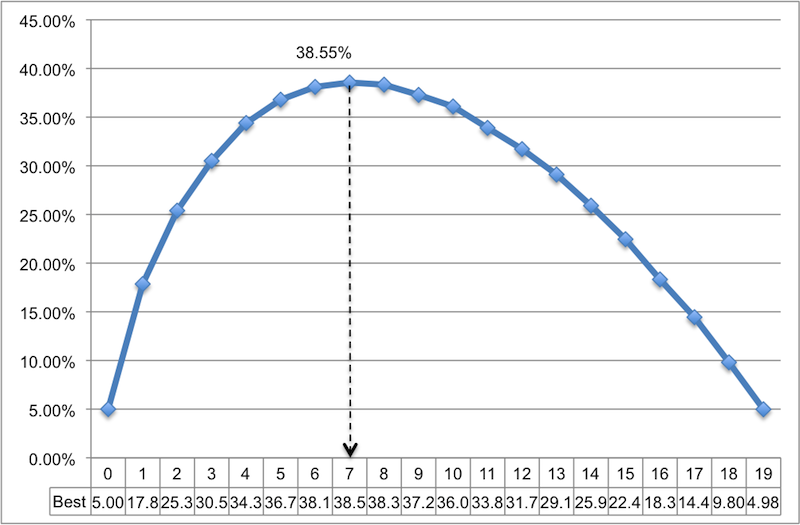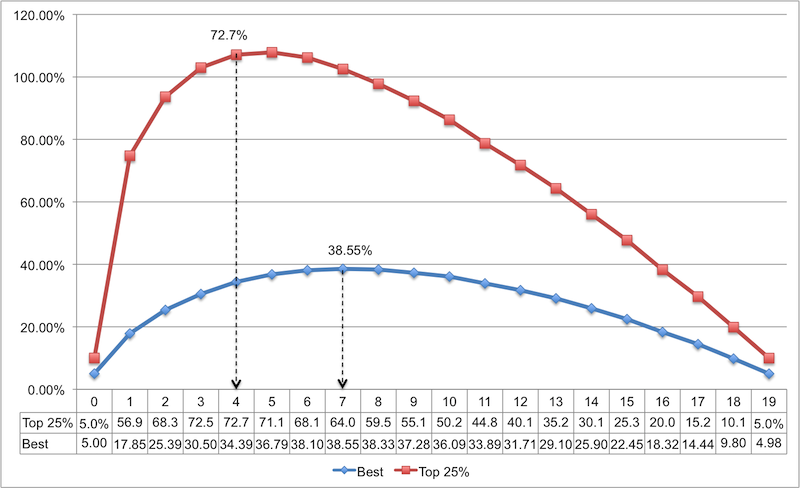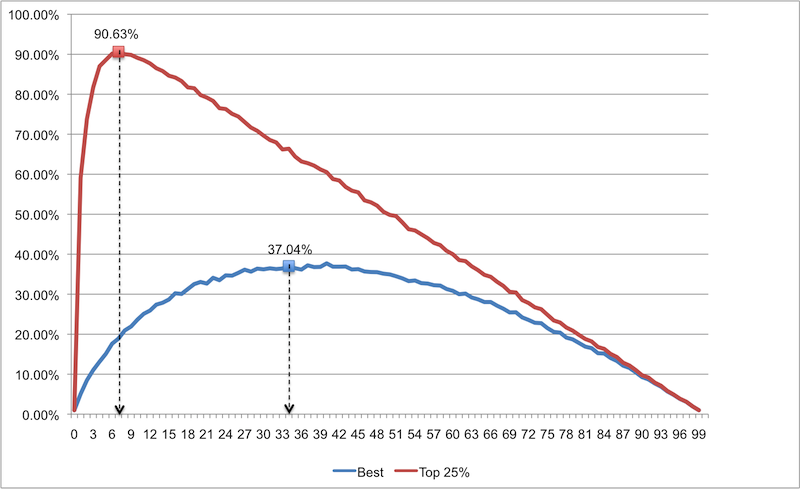How to hire the best engineers without killing yourself
- Transfer
The Garena I currently work for is in the process of growth and I am hiring engineers, system administrators, and similar staff to satisfy the appetites of the growing platform and meet the plans and deadlines for the release of products. The problem that I constantly encounter is that not only our company is engaged in the search and hiring of engineers. This is especially true now, when many companies have published their annual bonuses (or lack thereof) and unsatisfied ordinary employees of the companies join the ranks of applicants. In other words, musical chairs with companies and engineers gather in a heap.
“Musical chairs” (children's play; children walk around a row of chairs to music; when the music stops, the players rush to occupy chairs, which are one less than the ones playing)
Needless to say, this is causing some hiring difficulties. It is gratifying that there are many candidates. However, the flip side of this fact is the problem of retaining a highly qualified engineer with an adequate mindset within the framework of a growing startup. At the same time, the selection and approval of the candidate should be quick, since delay, even with a partially suitable candidate, is fraught with his loss within one to two days.
This makes me wonder which way is best if you have a large list of candidates and, in the end, choose the best engineer or, in any case, the one who is among the best on this list.
In the book Why Flip a Coin: The Art and Science of Good Decisions , HW Lewis wrote about a similar (albeit more rigorous) problem related to acquaintance. Instead of choosing candidates, the book tells about choosing a wife, and instead of conducting interviews, the problem of dating is considered. However, unlike a book where it is assumed that you can only meet with one person at a time, in my situation, I can obviously interview more than one candidate. However, the problems that arise are largely unchanged; if I interview too many candidates and spend too much time making a decision, they will be intercepted by other companies. Not to mention the fact that I, probably, even before that will die with foam at the mouth from an overdose of communication.
In the book, Lewis proposed the following strategy - let's say we select from a list of 20 candidates. Instead of interviewing everyone, we randomly select and interview 4 candidates and select the best one from this sample list. Now that we have in stock this best of these 4 candidates, we interview the rest of the list one at a time until we meet someone better and, in the end, hire this candidate.
As you may have guessed, this strategy is probabilistic and does not guarantee the selection of the best candidate. In fact, there are 2 worst-case scenarios. Firstly, if we accidentally choose the 4 worst candidates as a sample list and the first candidate selected from the rest of the list is 5 m worst, then we will hire the 5th worst candidate. Not good. Conversely, if the best candidate is on the sample list, then we run the risk of 20 interviews and then lose this best candidate, because the whole process took too much time. Bad again.
So is this a good strategy? In addition, what is the optimal size of the list (total number of candidates) and sample list we need in order to get the most out of this strategy? Let's be good engineers and use Monte Carlo simulation to find the answer.
Let's start with the size of the list of 20 candidates, and then sort through the number of the sample list from 0 to 19. For each sample list, we find the probability that the candidate we select is the best candidate in the list. In fact, we already know this probability if the sample list is 0 or 19. If the sample list is 0, the first candidate we will interview will be selected (since there is no one to compare with), so the probability is 1/20, and is 5%. Similarly, with the sample list equal to 19, we will have to choose the last candidate and the probability of this is also equal to 1/20 and is 5%.
Here is the Ruby code modeling this. Run the simulation 100,000 times to calculate the probability as accurately as possible, and save the result in the CSV file optimal.csv
The code is pretty self-evident (especially with all the comments), so I won’t go into details. The result is shown below on the line chart, after opening and marking the file in MS Excel. As you can see, if you select 4 candidates as a sample list, you will have about 1 chance out of 3 that you choose the best candidate. Better chances if you select 7 candidates as a sample list. In this case, the probability that you will choose the best candidate is about 38.5%. It doesn't look very good.

But, frankly, in the case of several candidates, I do not need the candidate to be “the best” (in any case, such assessments are subjective). Suppose I want to get a candidate in the top quarter of the list (top 25%). What are my chances then?
Here is the revised code that models this.
In the Optimal.csv file, we added a new column that contains the top quarter (top 25%) of the candidates. Below is a new chart. For comparison, the results of the previous simulation are added.

Now the result is encouraging, the most optimal size of the sample list is 4 (although for practical purposes 3 is good enough, since the difference between 3 and 4 is small). In this case, the probability of choosing a candidate from the top quarter of the list rushes to 72.7%. Sumptuously!
Now we will deal with 20 candidates. What about a list with a lot of candidates? How can this strategy sustain, say, a list of 100 candidates?

As you can see, this strategy is not suitable for determining the best candidate from a large list (the sample list is too large, and the probability of success is too low). This result is worse than what we obtained for a list with a smaller number. However, if we are satisfied with the candidate from the top quarter of the list (i.e., we will be less demanding), 7 candidates in the sample list are enough for us, while the probability of achieving the necessary results will be 90.63%. These are amazing odds!
This means that if you are a hiring manager with hundreds of candidates, you do not need to try to kill yourself by interviewing everyone. Just interview the sample list of 7 candidates, select the best one, and then interview the others one by one until you find one that is better than the best on the sample list. The likelihood that you select one of the top 25% of the list of 100 candidates will be 90.63% (and this will probably be the one you need)!
“Musical chairs” (children's play; children walk around a row of chairs to music; when the music stops, the players rush to occupy chairs, which are one less than the ones playing)
Needless to say, this is causing some hiring difficulties. It is gratifying that there are many candidates. However, the flip side of this fact is the problem of retaining a highly qualified engineer with an adequate mindset within the framework of a growing startup. At the same time, the selection and approval of the candidate should be quick, since delay, even with a partially suitable candidate, is fraught with his loss within one to two days.
This makes me wonder which way is best if you have a large list of candidates and, in the end, choose the best engineer or, in any case, the one who is among the best on this list.
In the book Why Flip a Coin: The Art and Science of Good Decisions , HW Lewis wrote about a similar (albeit more rigorous) problem related to acquaintance. Instead of choosing candidates, the book tells about choosing a wife, and instead of conducting interviews, the problem of dating is considered. However, unlike a book where it is assumed that you can only meet with one person at a time, in my situation, I can obviously interview more than one candidate. However, the problems that arise are largely unchanged; if I interview too many candidates and spend too much time making a decision, they will be intercepted by other companies. Not to mention the fact that I, probably, even before that will die with foam at the mouth from an overdose of communication.
In the book, Lewis proposed the following strategy - let's say we select from a list of 20 candidates. Instead of interviewing everyone, we randomly select and interview 4 candidates and select the best one from this sample list. Now that we have in stock this best of these 4 candidates, we interview the rest of the list one at a time until we meet someone better and, in the end, hire this candidate.
As you may have guessed, this strategy is probabilistic and does not guarantee the selection of the best candidate. In fact, there are 2 worst-case scenarios. Firstly, if we accidentally choose the 4 worst candidates as a sample list and the first candidate selected from the rest of the list is 5 m worst, then we will hire the 5th worst candidate. Not good. Conversely, if the best candidate is on the sample list, then we run the risk of 20 interviews and then lose this best candidate, because the whole process took too much time. Bad again.
So is this a good strategy? In addition, what is the optimal size of the list (total number of candidates) and sample list we need in order to get the most out of this strategy? Let's be good engineers and use Monte Carlo simulation to find the answer.
Let's start with the size of the list of 20 candidates, and then sort through the number of the sample list from 0 to 19. For each sample list, we find the probability that the candidate we select is the best candidate in the list. In fact, we already know this probability if the sample list is 0 or 19. If the sample list is 0, the first candidate we will interview will be selected (since there is no one to compare with), so the probability is 1/20, and is 5%. Similarly, with the sample list equal to 19, we will have to choose the last candidate and the probability of this is also equal to 1/20 and is 5%.
Here is the Ruby code modeling this. Run the simulation 100,000 times to calculate the probability as accurately as possible, and save the result in the CSV file optimal.csv
-
- require 'rubygems'
- require 'faster_csv'
-
- population_size = 20
- sample_size = 0..population_size-1
- iteration_size = 100000
- FasterCSV.open('optimal.csv', 'w')do|csv|
- sample_size.each do|size|
- is_best_choice_count = 0
- iteration_size.times do
- # создаем список и сортируем случайным образом
- population = (0..population_size-1).to_a.sort_by {rand}
- # получаем список-образец
- sample = population.slice(0..size-1)
- rest_of_population = population[size..population_size-1]
- # это лучший из списка-образца?
- best_sample = sample.sort.last
- # находим наилучшего выбранного этой стратегией
- best_next = rest_of_population.find {|i| i > best_sample}
- best_population = population.sort.last
- # наилучший ли это выбор? считаем сколько раз этот выбор наилучший
- is_best_choice_count += 1 if best_next == best_population
- end
- best_probability = is_best_choice_count.to_f/iteration_size.to_f
- csv <<[size, best_probability]
- end
- end
-
The code is pretty self-evident (especially with all the comments), so I won’t go into details. The result is shown below on the line chart, after opening and marking the file in MS Excel. As you can see, if you select 4 candidates as a sample list, you will have about 1 chance out of 3 that you choose the best candidate. Better chances if you select 7 candidates as a sample list. In this case, the probability that you will choose the best candidate is about 38.5%. It doesn't look very good.

But, frankly, in the case of several candidates, I do not need the candidate to be “the best” (in any case, such assessments are subjective). Suppose I want to get a candidate in the top quarter of the list (top 25%). What are my chances then?
Here is the revised code that models this.
-
- require 'rubygems'
- require 'faster_csv'
-
- population_size = 20
- sample_size = 0..population_size-1
- iteration_size = 100000
- top = (population_size-5)..(population_size-1)
- FasterCSV.open('optimal.csv', 'w')do|csv|
- sample_size.each do|size|
- is_best_choice_count = 0
- is_top_choice_count = 0
- iteration_size.times do
- population = (0..population_size-1).to_a.sort_by {rand}
- sample = population.slice(0..size-1)
- rest_of_population = population[size..population_size-1]
- best_sample = sample.sort.last
- best_next = rest_of_population.find {|i| i > best_sample}
- best_population = population.sort.last
- top_population = population.sort[top]
- is_best_choice_count += 1 if best_next == best_population
- is_top_choice_count += 1 if top_population.include? best_next
- end
- best_probability = is_best_choice_count.to_f/iteration_size.to_f
- top_probability = is_top_choice_count.to_f/iteration_size.to_f
- csv <<[size, best_probability, top_probability]
- end
- end
-
In the Optimal.csv file, we added a new column that contains the top quarter (top 25%) of the candidates. Below is a new chart. For comparison, the results of the previous simulation are added.

Now the result is encouraging, the most optimal size of the sample list is 4 (although for practical purposes 3 is good enough, since the difference between 3 and 4 is small). In this case, the probability of choosing a candidate from the top quarter of the list rushes to 72.7%. Sumptuously!
Now we will deal with 20 candidates. What about a list with a lot of candidates? How can this strategy sustain, say, a list of 100 candidates?

As you can see, this strategy is not suitable for determining the best candidate from a large list (the sample list is too large, and the probability of success is too low). This result is worse than what we obtained for a list with a smaller number. However, if we are satisfied with the candidate from the top quarter of the list (i.e., we will be less demanding), 7 candidates in the sample list are enough for us, while the probability of achieving the necessary results will be 90.63%. These are amazing odds!
This means that if you are a hiring manager with hundreds of candidates, you do not need to try to kill yourself by interviewing everyone. Just interview the sample list of 7 candidates, select the best one, and then interview the others one by one until you find one that is better than the best on the sample list. The likelihood that you select one of the top 25% of the list of 100 candidates will be 90.63% (and this will probably be the one you need)!
